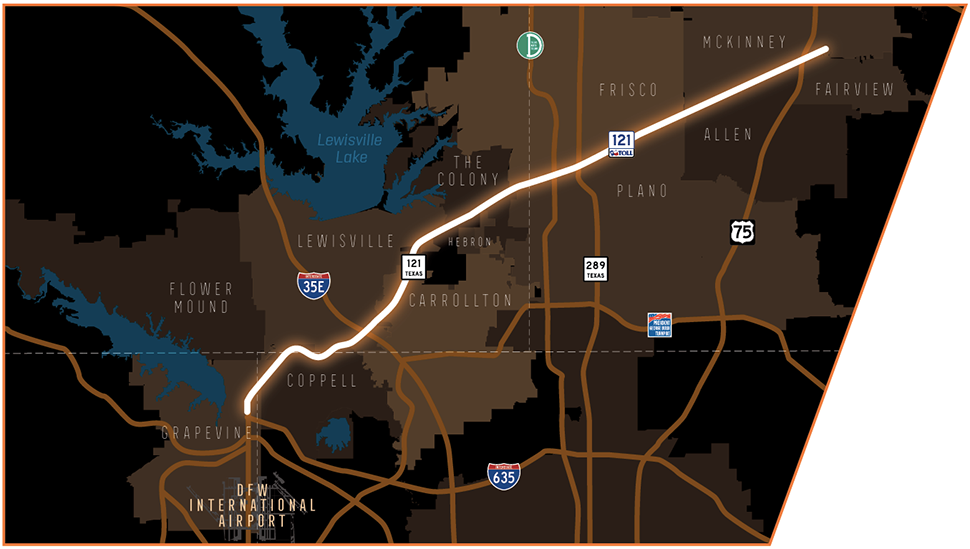To say the nearly 35-mile stretch from Dallas-Fort Worth International Airport to McKinney along State Highway 121 and the Sam Rayburn Tollway is a hotbed for development would be a bit of an understatement. The region, with its booming population, easy access to transportation, and high-density development has been transformed from what not long ago was considered the far-off suburbs to an urban oasis with plenty of restaurant, retail, and office amenities.
A new breed of urbanism is taking hold in edge cities all along the corridor, helping to make the area a destination for the live-work-play triangulate that is vital in attracting and retaining talent.
But it wasn’t always this way. Rewind back 20 years to a time when State Highway 121 was two lanes, and a four-wheel drive vehicle was needed to access some of the more remote areas of the corridor. An enterprising—and some might say foolish—David Craig purchased his first 1,125 acres in September of 2000 along 121, located, as Craig puts it, “on the edge of nowhere.”
“When we started developing, people thought we were crazy to be building in Oklahoma,” Craig says. His eponymous Craig Ranch hugs the easternmost edge of the corridor and now includes more than 2,200 acres. The development is among those that started it all and spurred a building boom in the early 2000s for the region. “Now, all the projects we’re working on could be considered infill,” he says.
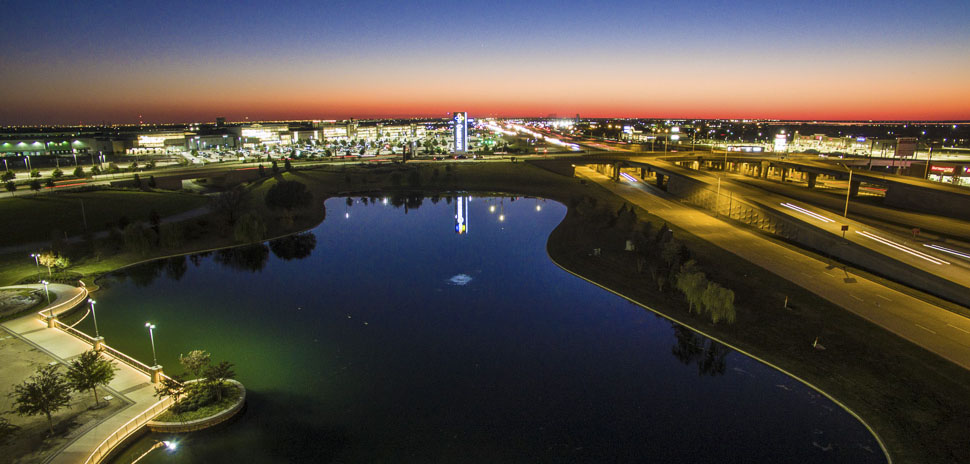
[Photo: Michael Samples]
Other early visionaries include Chris and Clay Bright, owners of Bright Realty Co., whose 2,500-acre Castle Hills master-planned community near the Dallas North Tollway and Park Boulevard in Denton County. The land was originally purchased in the 1950s by the Bright brothers’ late father and former Dallas Cowboys owner H.R. “Bum” Bright for the family’s recreational use.
Craig Hall kicked off construction at his office park in Frisco back in 1998 when the development didn’t even have a paved road that led to it. Twenty years later, the developer continues to add to his 162-acre park—now on his 17th building. Frisco’s HALL Park led the way for development along 121 and up the Dallas North Tollway, including The Star and Frisco Station—all part of the city’s Frisco North Platinum Corridor.
READ NEXT The Road to Everywhere: Highlights of Projects and Development in the 121 Corridor
Robert Shaw, CEO of Columbus Realty, is famous for incorporating walkability into his multifamily developments in the region, with projects along the corridor currently underway in Legacy West in Plano and Craig Ranch in McKinney.
And finally, any conversation about 121 certainly must include visionary Fehmi Karahan’s name. Karahan’s 250-acre Legacy West is one of the most successful mixed-use developments in the country, attracting corporate headquarters and regional hubs such as Toyota, Liberty Mutual, JP Morgan, Boeing, J.C. Penney, and Pizza Hut, to namedrop a few. L3 Technologies, a major defense contractor, is the latest corporate relocation to the southeast corner of the Dallas North Tollway and State Highway 121 development, announced in August.
“Some of us have been developing along this corridor for a very, very long time. They’d call us overnight successes—18 years later,” Craig jokes.
Among the most recent projects completed at Craig Ranch is a 160,000-square-foot Independent Bank headquarters in the 1-million-square-foot Hub 121 office project. Overall, the development includes some 20,000 residents and 5,000 daytime employees. Craig says those numbers are projected to increase to 30,000 residents and 10,000 employees within the next five years.
“Some of us have been developing along this corridor for a very, very long time. They’d call us overnight successes—18 years later.”
David Craig
His Craig International has bought and sold more than 5,000 acres along the 121 corridor in the past 30 years, and he says that as the project reaches full buildout and his original vision is achieved, he will continue to look toward 121 for future development.
“With Craig Ranch, I always asked myself, ‘What makes a community?’” Craig says. “What I was singularly focused on is creating a sense of home here, a sense of belonging and place. … I’ve been fortunate to ride the wave through economic prosperity and depression and finish what I started. It’s been a fantastic 18 years—and you can bet that I’ll continue to develop on the corridor. That’s how much I believe in it.”
Connectivity and navigability
The first expansion of State Highway 121 and the tollway first opened in May 2006. Three years later, it was expanded again, running all the way from Coppell to McKinney. It was then that the tollway was renamed in honor of Samuel Rayburn, a former Texas congressman and the longest tenured Speaker of the House. Not only did this vastly improve the connectivity of the corridor, it also made transportation a key component—and draw—for the burgeoning region.
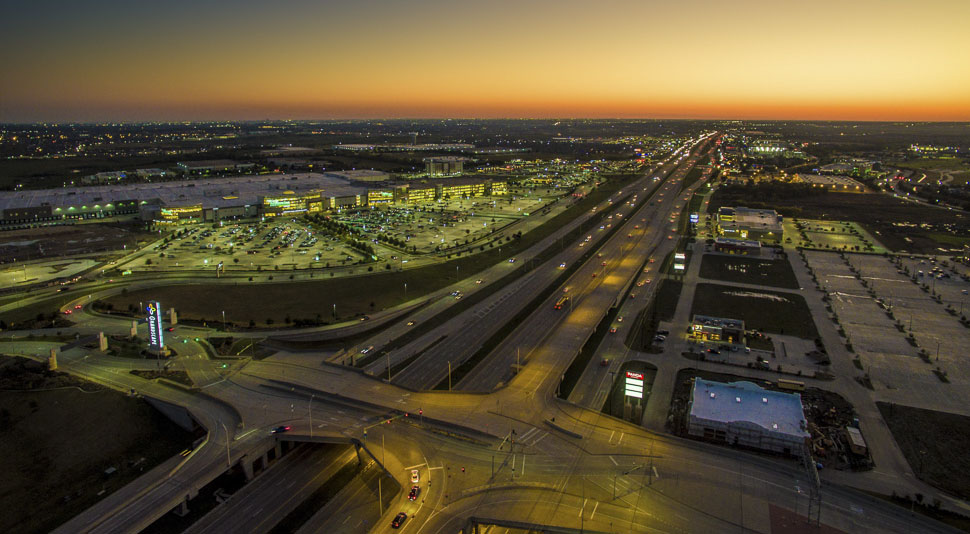
[Photo: Michael Samples]
“The 121 corridor has become the place to do business,” says Andrea Roy, economic development director for the city of Flower Mound. “It offers a rare combination of desired amenities, connectivity, and navigability. Its physical location allows businesses to attract workers from a uniquely broad radius. Very few places in the country can offer such an extensive list of positive attributes. Bottom line is that the area checks all of the boxes.”
Highlighting the connectivity on the western edge of the 35-mile corridor is Dallas Fort Worth International Airport. The fourth busiest airport in the country controls 17,000 acres, with 6,000 acres specifically earmarked for commercial development.
According to the latest quarterly Cushman & Wakefield industrial report, more than 15 million square feet of industrial product is under construction in DFW. The airport submarket has 6.1 million square feet of industrial product under construction during the third quarter, the most of any submarket in the metro, according to the report.
“The 121 corridor has become the place to do business. It offers a rare combination of desired amenities, connectivity, and navigability.”
Andrea Roy
The small community of Coppell is seeing a solid amount of industrial activity. It’s home to a recently opened 2.4 million-square-foot Amazon fulfillment center. Grapevine, where state highways 121 and 114 converge, recently saw the addition of two new luxury dealerships where Grubbs Infiti, Park Place Jaguar Land Rover, and Audi Grapevine already exist.
Along with Dallas Fort Worth International Airport, McKinney National Airport, which is on the eastern edge of the corridor, underwent a $16 million expansion and improvement project in late 2017. A recent study by the Airport Division of the Texas Department of Transportation Aviation found McKinney National Airport had a $212 million impact on the city last year—up nearly 400 percent from 2016.
“The next big opportunity in Grapevine will be the opening of the new train station in downtown at Main and Dallas Road,” says Bob Farley, Grapevine’s economic development director. “Whether it is planes, trains, or automobiles, we’re very excited about the future of transit-oriented development here. Grapevine is uniquely positioned to lead the conversation about transportation, especially given our location on the crossroads on so many major highways (121, 114, and 183).”
‘Destination shopping’
Moving east—and square in the middle of the 35-mile stretch of the 121 corridor—is Warren Buffett-backed Grandscape, the $1.5 billion, 433-acre mixed use development in The Colony. It’s also where Nebraska Furniture Mart opened in 2015.
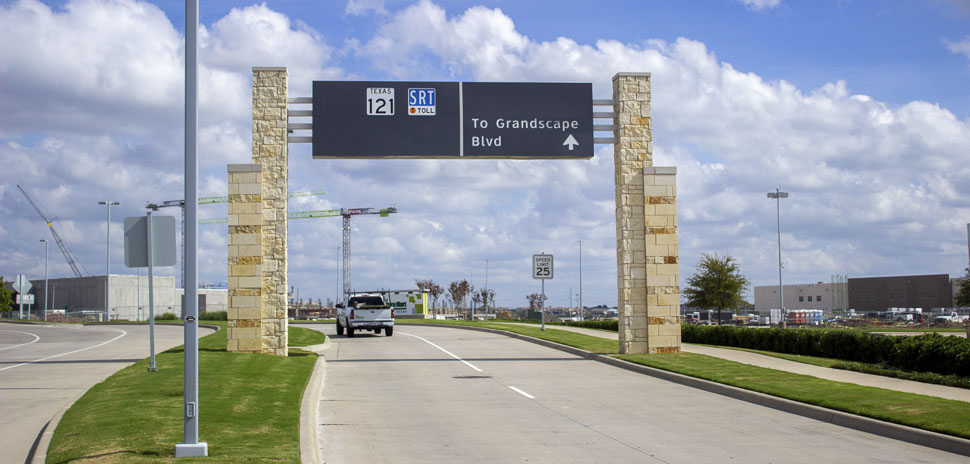
[Photo: Michael Samples]
David Palmer, executive vice president at Weitzman, says that led to an influx of more stores opening in the area. With IKEA less than four miles east near Frisco’s Stonebriar Centre, Palmer says the 121 corridor has become a must for home goods retailers relocating to the region. “What you see along 121 at Grandscape—especially since Nebraska Furniture Mart opened—is destination shopping,” he says. “Right across the highway from Nebraska Furniture Mart is one of the country’s busiest Rooms To Go stores. There’s also a Mattress Firm right there, and I dare you to try to find a spot in that parking lot on a Saturday afternoon. You won’t find it.”
Destination shopping 10 years ago meant looking no further than Frisco’s Stonebriar Centre. It was a particular turning point in the history of the 121 corridor, spurring expansion of the Sam Rayburn Tollway to accommodate shopping traffic and creating a robust tax base for Frisco to drive economic expansion to the city.
Destination shopping on the corridor today has paved the way for more entertainment options, like Topgolf, which opened its 121 location in April 2014, and, more recently, Hawaiian Falls water park in The Colony.
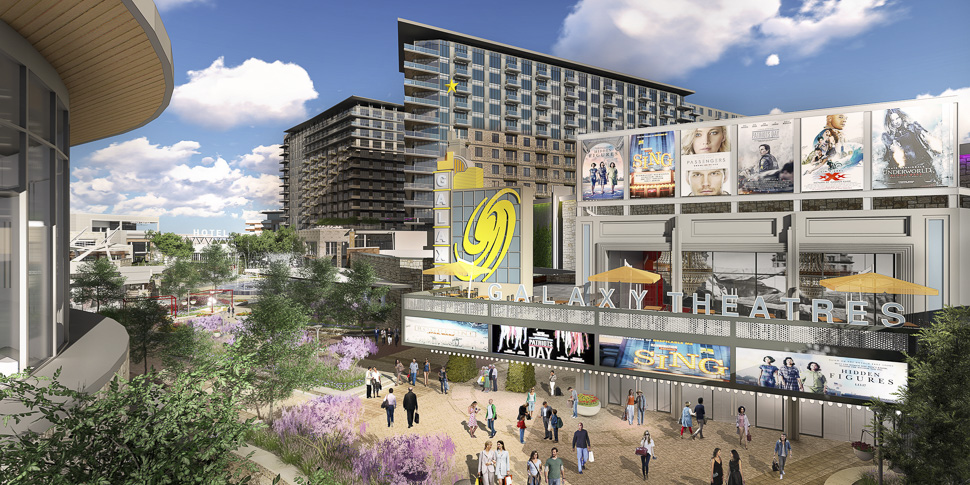
Galaxy Theatres in The Colony is expected to open in spring 2019. [Photo: Grandscape Images]
The largest multifamily redevelopment right now nearest Grandscape and located on the north side of the highway across from Legacy West in Frisco, is the $850 million, 60-acre, 1,000-unit Spring Creek Frisco 45. There’s also 80,000 square feet of retail and a full-service hotel planned for the development, which will be constructed around a series of parks and open spaces.
‘Crossroads of Collin County’
The easternmost border of the corridor sees the convergence of Highway 75 and the Sam Rayburn Tollway, known by many as the “Crossroads of Collin County.” The quadrants include the cities of McKinney, Frisco, Allen, and Plano.
Most recently announced along the southeastern quadrant in Allen is the master-planned Monarch City, a 270-acre development with plans for 9 million square feet of Class-A office, retail, and residential space, plus a luxury hotel. The Howard Hughes Corp. is the developer.
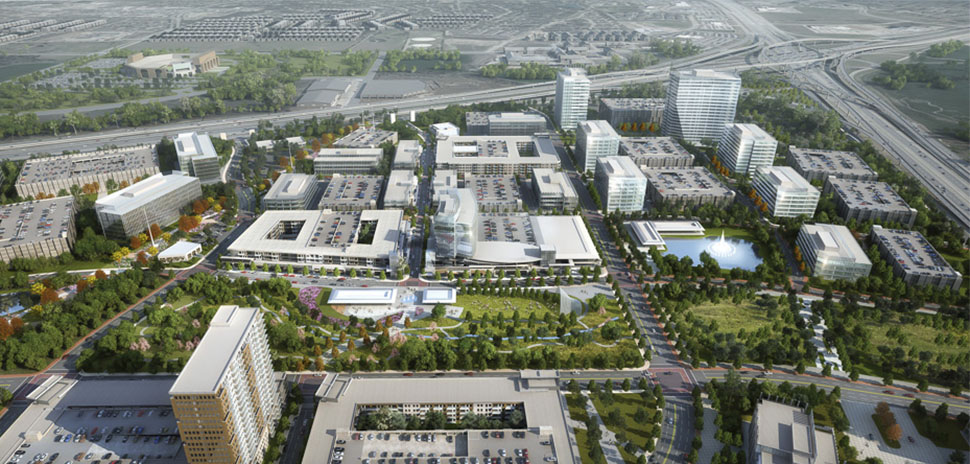
Monarch City is a 270-acre urban-suburban development. [Rendering: OMNIPLAN]
Mark Bulmash, the senior vice president overseeing the project for Howard Hughes, says the development will redefine the urban-suburban experience.
“It wasn’t too long ago that you escaped the city for good schools to raise a family, with homes on big lots with large yards,” he says. “That all is changing. With Monarch City, we’re looking to attract 20,000 jobs to the development. There’s potential to have 600,000 to 700,000 people in the area, which is amazing.”
He says Monarch City doesn’t have a timeline for development, and that the company is currently shopping the market for its first corporate tenants. However, Bulmash did say that Monarch City’s development would be focused on maintaining the natural ecosystems with more than 20 acres of parks, ponds, and hike and bike trails.
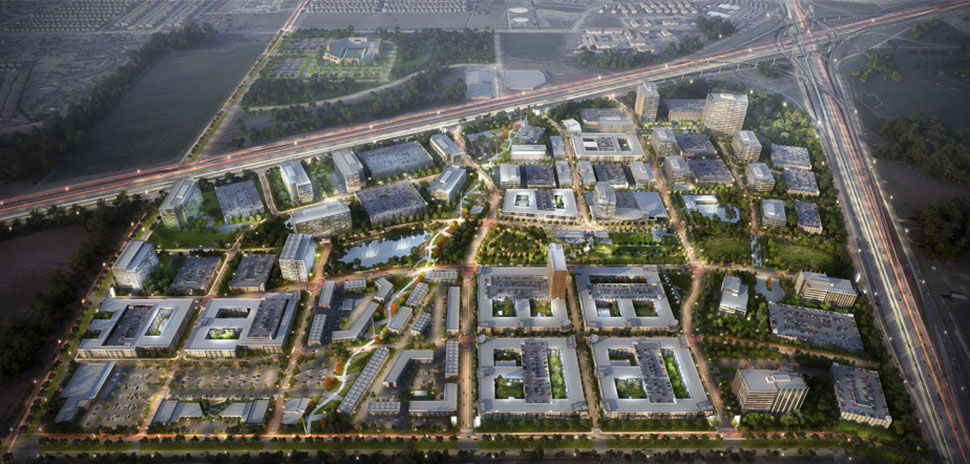
[Rendering: OMNIPLAN]
“There is a creek that runs through the land that will make for great pathways and hiking,” Bulmash says. “When you think of North Texas, you might think of flat land. But that’s not the case. We’re excited to include the natural topography of the land into our future designs for Monarch City.”
Bulmash says the name of the development derives from the area’s natural location in line with the migratory monarch butterflies that can be found in the region.
“There was this beautiful ‘aha’ moment for early-day founders of the area,” he says. “Butterflies symbolize fertility and we think it is such a great metaphor for the area’s farming heritage. … If you think about it, just like butterflies’ migration, we’re on the path of development. If you look at how developments are heading east along 121, we’re right in the natural path.”
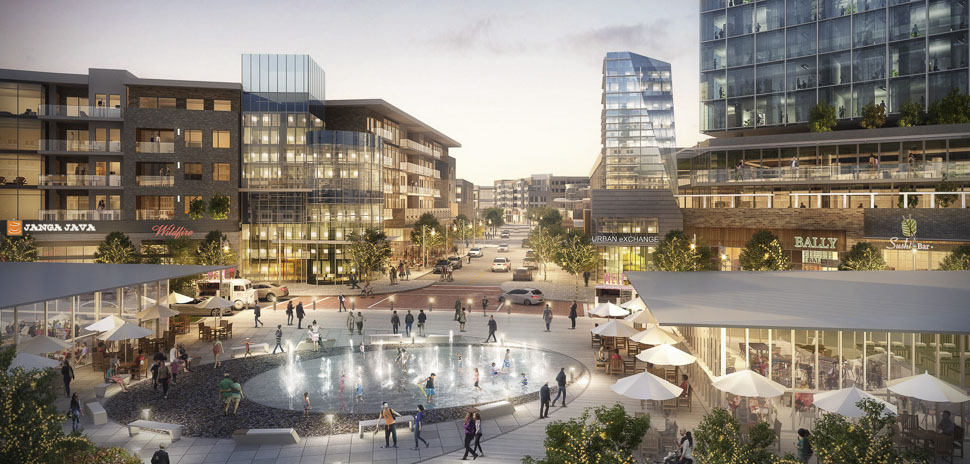
[Rendering: OMNIPLAN]
It has all added up to form a region that is “coming into its own,” says Scott Polikov, the president of Gateway Planning, who did much of the ground work for rezoning in many of the cities along 121.
“I think 121 is one of the coolest urban-suburban corridors in all of the country,” Polikov says. “David Craig set the stage and had the courage to say that this area could be an urban-suburban destination. Today, because of that vision, it is.”
What the experts are saying
Here are some of the reasons why the economic development leaders along the 121 corridor believe it is the premier place to do business in DFW.
“Location and proximity to cities with growing populations and employment. The Sam Rayburn Tollway provides a direct link to the DFW Airport wherever you are along the corridor.”
—NIKA REINECKE Reinecke, economic development director, Lewisville
“All of the mixed-use developments that been announced along Highway 121 provide housing for a growing workforce and provide important infrastructure for future growth for cities along the corridor, like Allen.”
—Dan Bowman, economic development director, Allen
“Highway 121 offers a blend a state-of-art connectivity with an authentic community feel you can’t find anywhere else in the country.”
—Bob Farley, economic development director, Grapevine
“Location, location, location.”
—Peter Tokar, economic development director, McKinney
“We’re a growing family entertainment destination, and the surplus of restaurant and retail options are unparalleled.”
—Keri Samford, economic development director, The Colony
“Quality education. We’re educating tomorrow’s workforce. Some of the highest-performing schools in the state are located right here.”
—Ron Patterson, economic development director, Frisco
Highlights of Projects and Development in the 121 Corridor
What exactly is making the 121 corridor the destination for urban-suburban development and new CBD in the Dallas-Fort Worth region? Click on the map to see the developments going on around the region that are all playing a part in making it thrive.
Read the digital edition of Dallas Innovates’ sister publication, the Real Estate Review, on Issuu.
Sign up for the digital alert here.
![]()
Get on the list.
Dallas Innovates, every day.
Sign up to keep your eye on what’s new and next in Dallas-Fort Worth, every day.


